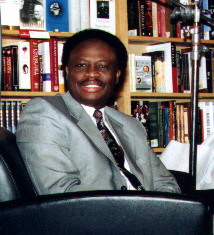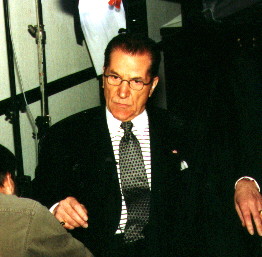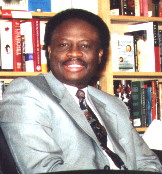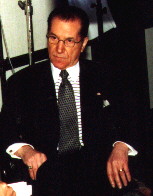|
| Press Release: January 2003 |
| News
Report: Forthcoming Documentary – Discovery Channel |
Making of a Documentary: How to
Prevent Medical Errors |
| 'Yinka
Vidal, BS. MA. HASCP. and Max Cohen, MD. being interviewed for the television segment of
the documentary by Bill Hockhauser of the Film Garden Entertainment of California. |

|
Left is 'Yinka Vidal, the author of 101 Ways to
Prevent Medical Errors during the television interview for the documentary |
|
|
|
|

|
Left is Max Cohen, MD. the Vice President and
Medical Chief Officer Missouri Baptist Medical Center |
|
|
|
Film Garden Entertainment of Hollywood,
California is producing a documentary called Medical Errors and Solution
Intervention for the Discovery Channel. This program is to be aired in the spring
of 2003. The documentary will include a few cases of medical errors across the nation and
interviews with experts on how to prevent such problems in the future. The program is
different from other news reports about medical errors because it discusses solution
intervention.
St.
Louis, Missouri, will be featured in the solution segment of the documentary. Again, the
Show-me State will show the whole nation how to solve the riddle of medical errors. In the
solution segment of the documentary, two experts from Missouri will be featured in the
program. Yinka Vidal, BS. MA. H.ASCP., and Max M. Cohen, MD. MHSA. FRCSC. FACS. FACPE., are being interviewed about their national studies
on how to prevent medical errors. ‘Yinka Vidal, the author of 101 Ways to Prevent
Medical Errors and the Chair of the National Campaign to Prevent Medical Errors, has
been working on medical errors for 25 years. He started working on solution intervention
more than three years ago. He has written two books on the subject matter and is presently
working on the third one. In his interview, he stresses that medical errors are not caused
by a complex health-care system, but rather by “simple systemic failures.” He
describes American medicine as being the best in the world and states that the United
States spends more money on the advancement of medical research than any other nation.
“But, there are defects in the processes of delivering care; those defects manifest
themselves as simple systemic failures,” says ‘Yinka Vidal.

|
|
The best way to
fix the problem of medical errors is to work directly with each of the processes of
delivering care, find the are defects and fix them, as he emphasizes in his seminars to
health-care workers. There is hardly any problem leading to medical errors that cannot be
resolved through process redesign, says the author.In this way, processes can be
reprogrammed to reduce the chances of errors. Another source of problem is the computer
systems used in many hospitals and their inability to spot errors. |
Most hospital computer systems are not
designed with effective checks and balances to avoid errors. Also, some of them are not
designed to handle the volume of information traffic being generated on them. The initial
primary goal of most hospital computer systems was to allow delivery of information
through automation. Today, we have to go back and redesign most of the systems with
embedded safety factors to reduce errors. When errors occur, “checks and
balances” can be built into the system to prevent the propagation of such mistakes
down the process-line of care. In a case where error causes harm to a patient, immediate
corrective action should be taken to remedy the situation and prevent further suffering or
damage to the patient. But, this cannot be done without looking at the entire process of
care.
“Solution
design resulting from root-cause analysis is not as difficult as many people may think.
But, the greatest challenge lies with the processes of solution implementation,”
stresses ‘Yinka Vidal, the author of 101 Ways to
Prevent Medical Errors and the Managing Editor of OUTCRY
Magazine. The hospital administrations must work hard to “buy-in” employees
on new ideas while workers must be energized to achieve positive results! He explains that
for solution intervention to be successful, three major components must be present. First,
the process of delivering care must be evaluated for defects, and the system must be
redesigned to prevent errors. Second, health-care workers must be made receptive to
improvement strategies. Third, health care institutions must foster the environment for
the successful implementation of solution intervention. For more information on solution
intervention, and why medical errors continue, read the article on Why Medical Errors
Continue – Part II: Solving the Mystery of Medical
Errors, by ‘Yinka Vidal - - - coming
soon.
Dr.
Cohen, the Vice President and Chief Medical Officer of the Missouri Baptist Medical
Center, is also featured in the solution-implementation segment of this documentary. In the interview, Dr. Cohen points out that humans
will always make mistakes. But, when errors occur, mechanisms should be put in place to
prevent such errors from occurring again. As humans, we are unwilling to accept the
reality that we make mistakes. In health care, as in any other industry, mistakes are very
common. In the past years not a lot of changes have taken place regarding medical errors.
He indicates that the total cost of medical errors greatly exceeds $10 billion annually.
In response to questions directed to him, Dr. Cohen gives some hints to other health care
professionals to help prevent errors. He stresses that surgeons should be careful
not to leave any surgical instrument inside a patient. A modern anesthetic machine will
monitor vital sign parameters, and it should be calibrated and be in good working
condition. He indicates that most hospitals are equipped to deal with emergencies, and the
out-patient surgery department should be regulated with the same guidelines as the regular
hospitals.

|
|
During the
interview Dr. Cohen said one of the most remarkable things regarding medical errors. He
stresses throughout the interview that a non-punitive approach is the best way to address
medical errors when they occur. He also emphasizes that errors are not caused by bad
people, but by defects in the processes of care. The most amazing thing said during
the interview is, “Medical errors claim two victims; the patient, and the
health-care workers.” Nobody has ever discussed the emotional pain and suffering
of the health workers involved. |
in this interview, Dr. Cohen is the
first person in the nation to bring that issue to light. He tells the public about the
suffering of the patients, and that of the health care workers involved. He indicates that
there is hardly any health care worker involved in an error who is not traumatized because
of it. The solution to medical errors is to fix systemic problems and put mechanisms in
place to prevent them from happening again.
This
type of documentary is very different from most other media reports about medical errors.
In the past, most news reports on medical errors were centered on problems without
discussing solution intervention or what hospitals were doing to remedy the situations.
Consequently, many health care workers and health care institutions shy away from such
reports because they create sensationalism, rather than help to explore solutions.
Although many hospitals are working to solve the problems, their efforts are hardly
rewarded by the media’s lack of interest in reporting about different solution
strategies. The Discovery Channel is leading the national media in discussing problems of
medical errors and solution interventions. This is the first time a major national medium
will be featuring solution intervention on medical errors and the barriers encountered by
those working to reduce these errors. Such a program on the Discovery Channel is very
important and laudable because it will educate the public about what health-care
institutions are doing to prevent errors. It will also teach patients how they can help to
be a part of their treatments, as well as open a door for a public dialogue regarding
solution interventions.
For
more information about the exact time and date the documentary will air, please visit www.101waystopreventerrors.com or www.discoverychannel.com
Bill
Hochauser, Tom Taglang and Roshika Vannie of Film Garden Entertainment of Hollywood,
California, produced the documentary for the Discovery Channel. Stay tuned for more
information about the forthcoming documentary. This is a program that all health-care
workers in the nation must see.
| Making of a Documentary: See the Rest in
Pictures |
|
Press Release by Lara Publications, Florissant, Missouri, Dec. 2002
|